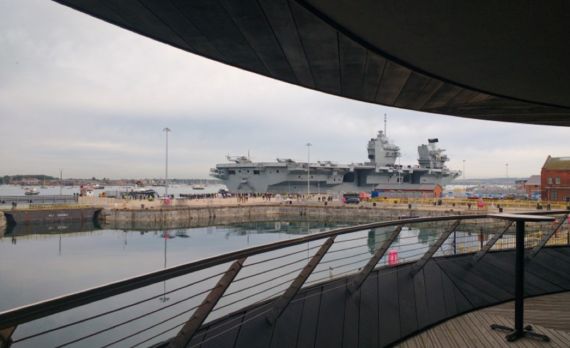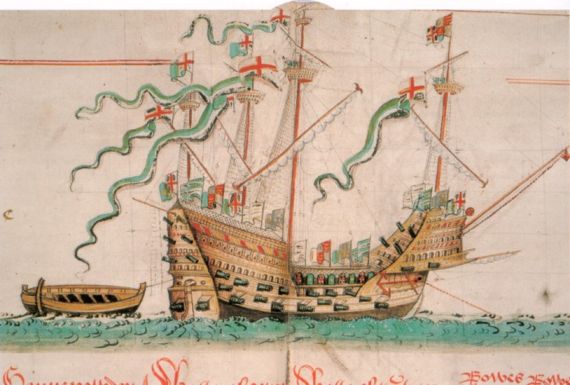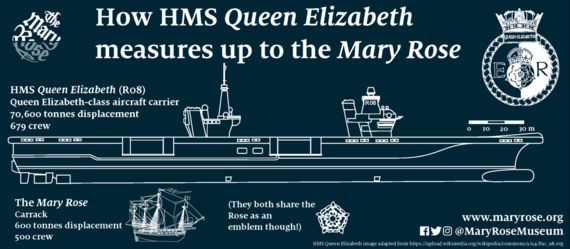The latest addition to the Royal Navy, HMS Queen Elizabeth, a 280 metre long aircraft carrier with 700 crew, arrived in Portsmouth recently, berthing just outside the Mary Rose Museum. The Mary Rose, though built for 500 crew, is dwarfed beside HMS QE: her exact length is unknown, but based on the existing keel we believe she was just over 40 metres. For 1511 the Mary Rose was a fairly large ship.

The view of HMS Queen Elizabeth from the balcony at the Mary Rose Museum
Tudor ships, the Mary Rose included, were highly decorated: covered in brightly coloured flags and streamers (although little has remained after 437 years of submersion in mud and seawater). In contrast, HMS Queen Elizabeth has a muted, grey colour scheme, signalling modern warfare's move away from pageantry and outward displays of aggression towards stealth and intelligence.

The Mary Rose depicted on the Anthony Roll. Image courtesy of the Pepys Library, Magdelene College, Cambridge
However, this stark difference of scale and aesthetic hides a fascinating link between these two monarch's warships. Both ships display that most British and historic of emblems: the Tudor Rose. The Tudor Rose represents the white and red roses of the York and Lancaster families, two branches of the the royal house whose rivalry resulted in a series of wars which became known as the Wars of the Roses. The result of the war saw the Tudor dynasty take the throne and the distinctive Tudor Rose, a mix of red and white petals, emerged as a symbol of the unification of the houses. This rose would later be displayed on the emblem, or figurehead, of the Mary Rose, a ship built by Henry VIII upon his accession to the throne in 1509. Centuries later, the emblem was discovered on the seabed, recovered in 2005, and reunited with the rest of her vessel when the Mary Rose Museum was fully revealed in 2016.

Courtesy of The Mary Rose Trust
Between 1545 and 2016 the Tudor Rose remained linked with ships called 'Mary Rose'. In fact, nine ships have held the name over the years; from the Mary Rose that fought the Spanish Armada in 1588, to the vessel that took on six Algerine frigates singlehandedly at the Battle of Cadiz in 1669. Another notable Mary Rose fought at the Battle of Jutland in 1916 before being lost defending a convoy off the coast of Lerwick in 1917. The name Mary Rose is currently used for the headquarters of the Basingstoke Sea Cadets and it still uses the Tudor Rose as its badge.
So, what would Henry VIII make of the HMS Queen Elizabeth? For the infamously opulent king who built many magnificent palaces during his reign (and whose tent at the Field of Cloth of Gold which would have been larger than most houses in Tudor England) a giant warship that could fit his entire navy on the flight deck would probably have delighted him. Also, for a man for whom gunshields and hailshot pieces were advanced weaponry, something that can carry several jet aircraft would have blown his mind.
Both ships are currently visible at Portsmouth Historic Dockyard, so if you're interested in seeing 500 years of naval history, you know where to go.
